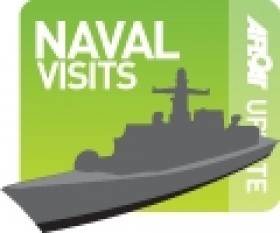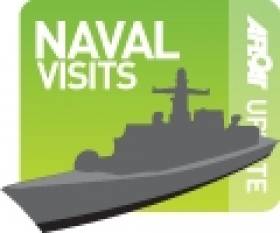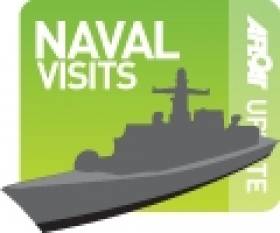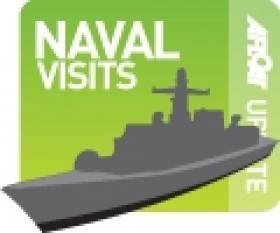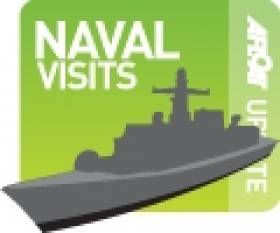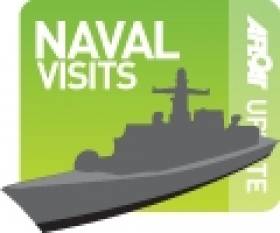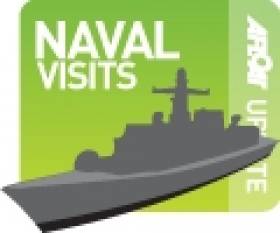Displaying items by tag: Naval Visits
Dutch Navy Replenishment Tanker Visitor Sold to Peruvian Navy
#DutchNavy – According to Ships Monthly, the Royal Netherlands Navy combat support ship HNLMS Amsterdam which visited Dublin Port in April, as previously reported (with photo) has been sold to the Peruvian Navy.
An economic upturn in Peru has enabled the acquisition of the 17,000 tonne auxiliary replenishment vessel (AOR), which can supply 8,475 tonnes of fuel and 290 tonnes of stores.
She is equipped with 30mm Goalkeeper CIWS systems and a large stern flight-deck and hanger capable of operating up to three medium-sized helicopters.
The 19 year old vessel is scheduled to be transferred to her new South American owners in December. Her sale leaves the Dutch Navy without a tanker until her replacement, Karel Doormen, the new Joint Logistic Support Ship due for delivery in 2015.
#NavalLegenderry - As well as the flotilla of the 12-strong Clipper Round the World Race yachts at the Legenderry Maritime Festival, the north-west city has welcomed a pair of tallships and a naval visitor on Lough Foyle.
The Naval Service's OPV80 class vessel which entered service in 1999, was made open to the public today while berthed at the city along McFarland Quay.
This day last week the offshore patrol vessel was off the south coast where she was expected to take part in a major annual naval exercise as previously reported, though she could not due to operational reasons.
This left newbuild L.E. Samuell Beckett and veteran L.E. Aoife to continue exercises involving Drug Interdiction Teams engaged in boarding practice and an Air Corps helicopter performing winching operations with the vessels off the coast of Cork Harbour.
The visit of L.E. Roisin on the Foyle consolidates relationships between these islands, noting she along with her sister L.E. Niamh were built at the UK shipyard of Appledore Shipbuilders Ltd in north Devon.
The yard near Bideford on the River Torridge is today part of Babcock Group's marine division where newbuild OPV90 L.E. James Joyce is under construction and where a third option of 'Beckett' class based on the 'Roisin' class was announced in recent weeks.
Largest New Dutch Navyship to Replace Recent Dublin Port Visitor
#DutchNavyLargest – Following last weekend's visit to Dublin Port of Royal Netherlands Navy (LPD) landing platform dock ship HNLMS Johan de Witt and (AOR) auxiliary replenishment tanker HNLMS Amsterdam, the latter is to be replaced by the Dutch Navy's largest vessel, a newbuild in 2015, writes Jehan Ashmore.
HNLMS Amsterdam and HNLMS Zuiderkruis, also an oil-fuels replenishment carrier, will be disposed by a the largest unit in the Dutch Navy, the €360m newbuild Karel Doormen at 28,246 tonnes and almost 207m in length. The Joint Logistics Support Ship (JSS) was constructed by the Damen Group's shipyard in Galati, Romania, the same yard that built Commissioners of Irish Lights ILV Granuaile.
The Karel Doormen was towed to her homeland and fitted-out at Vlissingen from where the newbuild was last month named by the Dutch Defence Minister Jeanine Hennis-Plasschaert. She is to undergo sea-trial next month and commissioned into service in 2015 and then officially named "HNLMS Karel Doormen". She will be a major asset for the Dutch Navy, NATO and the EU forces.
The JSS primary role asides replenishment at sea serving two vessels simultaneously and equally on that note the capacity to handle a pair of Chinnook helicopters on a flight deck plus a hanger for six more helicopters. In addition her JSS remit is to provide logistical support, strategy sealift and duties supporting of land-based forces.
Among the roles of the JSS, this is achieved by the provision of up to 2,000 lane metres for military vehicles and container-stores equipment accessed by a rear-quarter ramp.
Likewise to HNLMS Johan de Witt a landing platform dock (LPD) ship, the newbuild will transport troops and handle two landing craft, considerably less compared to up to 8 accommodated as of the older pair of LPD half-sisters, the other been leadship HNMLS Rotterdam.
Together these LPD vessels paid a visit to Dublin Port in 2007, which was notable and berthed within Alexandra Basin East and Ocean Pier, however more unusually for a foreign navy was to visit an Irish port during winter. On that occasion the call took place in November.
#USNavy - Dublin Port is host to a French 'Tripartite ' minehunter, a Dutch Navy amphibious landing platform dock ship and a fuel replenishment tanker, while in Cork Harbour, a United States Navy guided missile cruiser docked at Cobh this lunchtime today.
The USS Letye Gulf (CG 55) is a Ticonderoga class AEGIS Guided Missile Cruiser home-ported in Norfolk VA. She is to remain alongside the cruiseliner berth to next Friday and her visit is in advance of the first cruise caller this season with the Legend of the Seas due later this month.
In 2012, the 173m vessel successfully completed an 11 month Extended Selected Restricted Availability (ESRA) and Cruiser Modernization which included significant Combat Systems upgrades and extensive hull, tank and superstructure work.
Among her more recent roles, she was deployed in 2011 with the Enterprise Carrier Strike Group (CSG 12), Leyte Gulf supported anti-piracy operations and counter narcotic operations off the coast of Somalia.
In the previous year USS Leyte Gulf also supported the missile strikes against Lybia.
She too was involved with the Somali pirate hijacking of the motor vessel Quest in the Indian Ocean and captured 75 Somali pirates.
#LandingDockShip- HNLMS Johan de Witt (L801) an imposing yet impressive amphibious transport ship and HNLMS Amsterdam (A386) an auxiliary oil replenishment tanker of the Royal Netherlands Navy are to call to Dublin Port tomorrow, writes Jehan Ashmore.
HNLMS Johan de Witt is one of two such vessels also known as Landing Platform Docks (LPD) in the Dutch Navy and she is an enhanced verion of leadship class nameship HNLMS Rotterdam (L800) which has visited the capital before. The LPD half-sisters play an integral role in supporting ships in amphibious operations.
Earlier this month both the Dublin bound vessels formed part of a flotilla involved in exercises in the Irish Sea as they proceeded northbound.
HNLMS Johan de Witt is ten metres longer at 166m of 'Rotterdam' and can handle between 6-8 landing craft and is 16,500 tonnes. She will berth at Ocean Pier berth due to her 6m draft and likewise the 17,040dwt auxiliary oil replenishent (AOR) at sea vessel, HNLMS Amsterdam which has a larger draft of 8m. She is equipped with weapons systems and has a helideck and hanger for such aircraft.
The weapons systems of HNLMS Johan de Witt are .50 mm machine guns, 2 x Goalkeeper 30 mm and helicopters of 6 Lynx, NH-90, Chinook or Sea King helicopters. She can embark 600 units compared to her sister with that of 555 units.
The LPD can cater for either Landing Craft Vehicle and Personnel (LCVP) or Landing Craft Utility (LCU). In addition she can transport almost any type of vehicle. As well to carrying 32 Leopard 2 tanks and approximately 90 YPR armoured tracked vehicles and Patriot air-defence systems.
She is designed to be self-sufficient for at least a month and this involves supplies on board for a complete marine battalion and the ship's company. They are equipped with operating tables, intensive-care beds, treatment rooms and an emergency hospital for 100 patients.
French Mine-Hunter to be Third Visitor to Capital
#FrenchMineHunter - French Navy "tripartite" minehunter Andromède (M 643) is to be the third visitor by the nation to call to Dublin Port this year, writes Jehan Ashmore.
Unlike the Type A69 corvette FS Lieutenant de Vaisseau Lavallée (F 790) which berthed in the centre of Dublin Port last week, the minehunter is to dock closer to the city centre on the Liffey.
The design origins of the 51m minehunter stems from a commitment to construct a minehunter warfare vessel to meet the needs, share technologies and also reduce costs of building units for the French, Belgium and Dutch Navies.
Andromède has served globally among international operations in the Persian Gulf in 1991 having entered into commissioned service in 1984.
The 615 tonnes displacement minehunster was completed by la Direction des Constructions Navales (DCN) in Lorient, Brittany.
#RoyalNavy - As well to yesterday's inaugural Stena Explorer (HSS) highspeed sea service sailing this year from Holyhead to Dun Laoghaire Harbour, a Royal Navy inshore fast-patrol training boat followed in her wake, writes Jehan Ashmore.
HMS Express (P163) speed across the Irish Sea at some 17 knots from the Anglesea port while the HSS fast-ferrycraft surged ahead at almost 24 knots during her first crossing of the seasonal-only operated service of five months duration until 9 September.
The Archer P2000 class 20m patrol boat follows the visit of one of her 14 sisters, HMS Exploit (P127) which too made a call to Dublin Bay ports, firstly at the Poolbeg Yacht & Boat Club's marina in Ringsend and last week to Dun Laoghaire Harbour Marina.
The primary function of the P2000 class which form the First Patrol Boat Squadron is supporting the University Royal Naval Units (URNU) in addition they contribute to other wide range roles.
The URNU is based at HMS Cambria, a Royal Navy Reserve establishment near Cardiff and some of the patrol boats are based at Penarth Marina in Cardiff Bay.
Royal Navy Patrol Training Boats to Visit Dublin Bay Ports
#PatrolBoats – Two Royal Navy P2000 'Archer' class inshore fast-patrol and training boats will have visited both Dublin Bay ports by the middle of next week, writes Jehan Ashmore.
HMS Exploit (P127) which recently paid a visit to Dublin Port at the Poolbeg Yacht & Boat Club's marina was also followed by a short-hop across the bay to Dun Laoghaire Harbour Marina where she departed yesterday evening.
She had set originally off from Penarth Marina near Cardiff and made en route call to Ireland via Milford Haven. A sister HMS Express (P163) is due to Dublin Port in several days time.
Both 20m boats as previously reported on Afloat.ie called to Dun Laoghaire Marina a year ago.The pair as previously mentioned belong to the Archer P2000 class numbering 14 vessels and which form the First Patrol Boat Squadron.
Their primary function is supporting the University Royal Naval Units (URNU) in addition they contribute to other wide range roles. The URNU is based at HMS Cambria, a Royal Navy Reserve establishment near the Welsh capital.
French Navy Corvette to Call to Capital
#FrenchCorvette – The French Navy are to return to Dublin Port as a Type A69 corvette FS Lieutenant de Vaisseau Lavallée (F 790) is to dock tomorrow, writes Jehan Ashmore.
Last month, the anti-submarine frigate FS Primauguet (D 644), made a four-day call to the capital having undertook exercises in the Norwegian fjords.
As for the FS Lieutenant de Vaisseau Lavallée she is also known as a D'Estienne d'Orves class corvette which entered service in 1980. The 1,250 tonnes corvette is armed with Excocet missiles and other defence attack systems. She is to berth at Ocean Pier, facing opposite the Poolbeg Yacht & Boat Club.
Her visit will also follow a German Navy Task Group which comprised of an oil replenishment, stores and equipment vessel and three frigates that called during the St. Patrick weekend.
German Navy Training Task Group Visit Dublin Port in between NATO Exercises off Norway and West Africa
#GermanNavy – A German Navy Training Task Group which docked yesterday in Dublin Port in the run-up to the St. Patrick' weekend has completed taking part in a NATO maneuver "Dynamic Goose" in the Norwegian Sea, writes Jehan Ashmore.
To see the route of the Training Task Group including those conducted in the Norwegian Sea (click link for map) . The flotilla of four vessels are making the port of call to Dublin Port until Tuesday and they will not be open to the public.
The largest vessel is Frankfurt am Main (A1412), a Berlin-class group supply vessel. The 174m long auxiliary oiler replenishment (AOR) can also handle containers for military equipment, stores and an aft deck for helicopters.
Accompanying the AOR are three frigates, the Augsberg, Hamburg and Oldenberg and for further details click link in opening paragraph.
Following the Irish visit, the task group are planning to take part in the up-coming maneuver "Obangame Express" in the Gulf of Guinea off the west African state, again refer to map-link above.



























